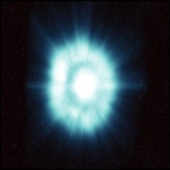ESA Science & Technology - News Archive
News archive
News archive
Between 4-7 October a symposium on the scientific aspects of the Gaia mission was held at the Observatoire de Paris. The meeting covered the current status of the Gaia mission and reviewed recent working group studies.
Published: 13 October 2004
A new study of a large number of planetary nebulae has revealed that rings, such as those seen here around the Cat's Eye Nebula, are much more common than thought so far and have been found in at least one third of all planetary nebulae.
Published: 9 September 2004
Published: 19 August 2004
The strong stellar wind and intense ultraviolet radiation of a young hot star is blowing a bubble into the surrounding gas. The object, known as N44F, lies in our neighbouring dwarf galaxy the Large Magellanic Cloud.
Published: 13 August 2004
Published: 6 August 2004
Herschel's primary mirror blank has been transported to Finland for a final polish prior to the application of the reflective aluminium layer early next year.
Published: 6 July 2004
Hubble has captured a subregion of the second largest star-forming region, N11, in the Large Magellanic Cloud.
Published: 1 July 2004
An international team of astronomers using the world's biggest telescopes have directly measured the mass of an ultra-cool brown dwarf star and its companion dwarf star for the first time.
Published: 15 June 2004
Using data from the Hipparcos and Tycho-2 catalogues, both generated from data acquired by the ESA Hipparcos mission, the Hayden Planetarium has developed a high precision model of our galaxy.
Published: 28 May 2004
The Wide Field Planetary Camera 2 onboard the Hubble Space Telescope, has revealed startling new details of HD 44179, commonly called the "Red Rectangle". It is one of the most unusual nebulae known in our Galaxy.
Published: 11 May 2004
A new image of the Bug Nebula, NGC 6302 taken with the Hubble space telescope reveals fresh detail in the bright and extreme planetary nebula.
Published: 28 April 2004
Published: 18 March 2004
The bubble-like structures seen in this HST image of the nearby dwarf galaxy NGC 1596, reveal the impact of vigorous star birth activity on the interstellar medium.
Published: 3 February 2004
Results from the HST played a major role in preparing ESAs ambitious Rosetta mission for its new target, comet 67P/ Churyumov-Gerasimenko. Hubble measured precisely the size, shape and rotational period of the comet.
Published: 5 September 2003
Published: 23 July 2003
Published: 23 March 2003
Published: 13 November 2001
Published: 25 October 2001
—
20 Items per Page

















